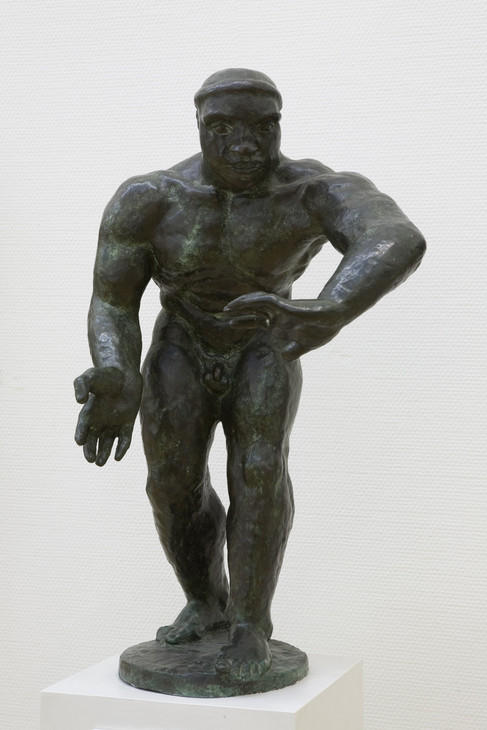Poetry and Literature
Have just bought two statuettes from the coming sculptor, Gaudier-Brzeska. I like him very much. He is the only person with whom I can really be ‘Altaforte’
We are getting our little gang together after five years of waiting.1
We are getting our little gang together after five years of waiting.1

Henri Gaudier-Brzeska
The Wrestler 1912, cast 1945
Bristol Museum and Art Gallery
Fig.1
Henri Gaudier-Brzeska
The Wrestler 1912, cast 1945
Bristol Museum and Art Gallery
It seems significant that Pound and Gaudier-Brzeska met in front of one of his wrestling sculptures. In the short period between first meeting one another at the Allied Artists exhibition in 1913, Gaudier-Brzeska and Pound established an intimate friendship in which they often engaged in ideological combat together, or in support of one another, against their contemporaries.5 ‘The New Sculpture’, published in the radical, anarcho-individualist journal the Egoist on 16 February 1914, was Pound’s first real piece of art criticism, although, as literary historian Rebecca Beasley has aptly demonstrated, the poet had been engaging with writing about the visual arts in published and unpublished work before this date.6 The back page of this issue of the journal also carried reproductions of two pieces by Gaudier-Brzeska and one of his drawings. This article was, among other things, a call for a new conception for the role of the artist and alighted on the work of the sculptors Pound had recently encountered in London, the American Jacob Epstein and Gaudier-Brzeska.
Sculpture and sculptors were clearly central to Pound’s ‘gang’, and, more broadly, to the conception of a radical, militant avant-garde art that he was promoting on the pages of the Egoist. The article was a manifesto for ‘this new wild sculpture’. Pound envisaged the restoration of a hierarchical cultural code through ‘craft’ and ‘violence’, resulting in the renewal of the moral and spiritual potential of the artist’s craft and labour.7 In this essay, Pound associated this ‘new wild sculpture’ with a violence and combat that suited his own pugnacious rhetoric. Pound and Gaudier-Brzeska shared and responded to each other’s ideas about violence, force and creativity and established a critical relationship which started with a fortuitous and somewhat appropriate meeting in front of one of Gaudier-Brzeska’s sculptures of a wrestler. It is in the spirit of the strong ties that Gaudier-Brzeska and Pound forged between sculpture, poetry, art criticism and a rhetoric of combat that the contemporary poet S.J. Fowler, who is also a trained wrestler, has written a response to Wrestlers.
Notes
Ezra Pound to William Carlos Williams, 19 December 1913, in D.D. Paige (ed.), The Letters of Ezra Pound, 1907–1941, London 1951, p.65. ‘Altaforte’ is a reference to Pound’s poem Sestina: Altaforte (1909) about a twelfth-century nobleman, Bertran de Born, who loved to fight and is described by Pound in the poem as a ‘stirrer-up of strife’.
For a discussion of Gaudier-Brzeska’s name, see Jon Wood, ‘“C’est s’appelle tout simplement Jaersh-ka”: The Eastern European Imaginary of Henri Gaudier-Brzeska’, in ‘We the Moderns’: Gaudier-Brzeska and the Birth of Modern Sculpture, exhibition catalogue, Kettle’s Yard, Cambridge 2007, pp.65–74.
Ezra Pound, Gaudier-Brzeska: A Memoir, 1916, New York 1970, p.44. Pound also described Gaudier-Brzeska coming after him and Olivia Shakespear at the exhibition ‘like a well-made young wolf or some soft-moving, bright-eyed wild thing’ (p.44). This description was the inspiration for the title of the 2009 exhibition at the Royal Academy of Arts in London, Wild Thing: Epstein, Gaudier-Brzeska, Gill.
For more on Gaudier-Brzeska and Pound’s friendship, see Richard Cork, Henri Gaudier & Ezra Pound: A Friendship, London 1982. For a discussion of sculpture’s role in Pound’s conception of an avant-garde ‘gang’, see Sarah Victoria Turner, ‘Ezra Pound’s New Order of Artists: “The New Sculpture” and the Critical Formation of a Sculptural Avant-Garde in Early Twentieth-Century Britain’, Sculpture Journal, vol.21, no.2, 2012, pp.9–12.
How to cite
Sarah Victoria Turner, ‘Poetry and Literature’, July 2013, in Sarah Turner (ed.), In Focus: 'Wrestlers' 1914, cast 1965, by Henri Gaudier-Brzeska, Tate Research Publication, July 2013, https://www
